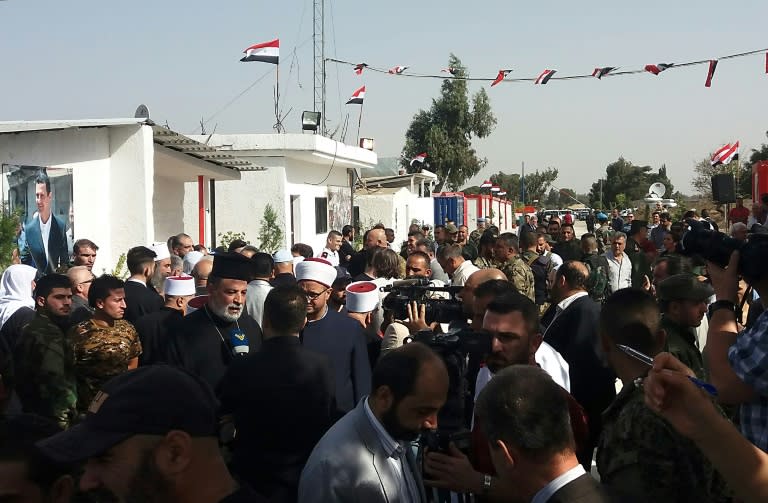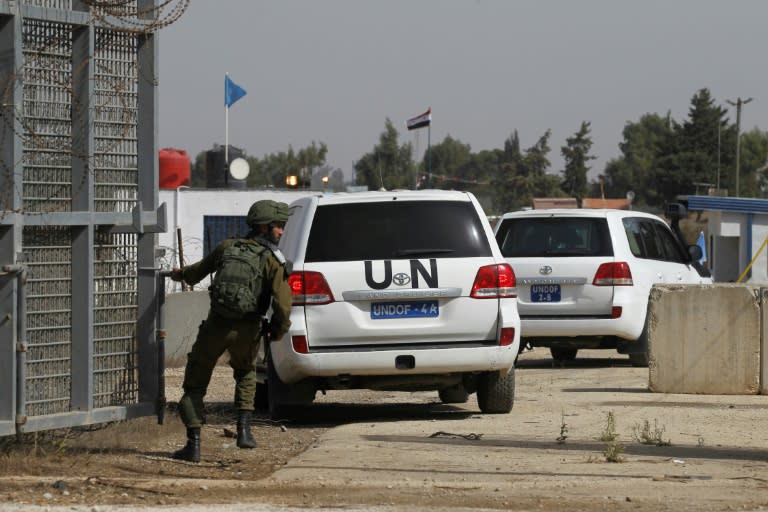Sole crossing between Syria and Israel-held Golan reopens
The sole crossing point between Syria and Israeli-controlled territory reopened Monday after a four-year hiatus, as Syrian President Bashar al-Assad's regime bolsters its control in the wake of sweeping advances against rebels. The reopening of the crossing on the Golan Heights was the result of a deal between Israel, Syria and the United Nations, and it will allow UN peacekeepers to monitor the region. Two UN white jeeps crossed into Israeli-controlled territory through the reopened crossing near Quneitra in the Golan Heights, during a low-key ceremony. The Syrian flag was raised on Syria's side of the crossing, an AFP correspondent said. The main border crossing between Syria and Jordan also reopened on Monday. The Quneitra crossing is used primarily by the UN Disengagement Observer Force (UNDOF), which has around 1,000 troops to monitor a ceasefire line separating Israeli-occupied parts of the Golan Heights from Syria. UNDOF resumed its patrols in the area of the crossing point in August, after withdrawing in 2014 when Al-Qaeda-linked rebels overran the area. An Israeli military official said initially the crossing would open twice a day for UNDOF forces, but openings could be expanded in the coming months. - Lifeline - Assad's forces, backed by Russian and Iranian military support, have regained control of large swathes of Syria in the past year, including forcing rebels from the Quneitra region and also along the border with Jordan. Israel seized much of the Golan Heights from Syria in the Six-Day War of 1967 and later annexed it in a move not recognised by the international community. The Jewish state supported some rebel groups in the Golan during the seven-year Syrian civil war, seeking to create a buffer zone against Iranian influence. Last month, it ended its 'Good Neighbour' support programme for rebels in the Golan that saw thousands brought to Israel for medical treatment, as well as aid shipped across the border. It has expressed concern that Iranian-backed groups allied to Assad, including Lebanese militant group Hezbollah, could move into the Golan, creating a threat to Israeli cities. So far there is no Hezbollah presence near the crossing, according to the Syrian Observatory for Human Rights, and the Israeli army has said it expects the UNDOF forces to keep "hostile groups" from the region. The United States has hailed the reopening, saying it would "allow UN peacekeepers to step up their efforts to prevent hostilities in the Golan Heights region". Syria and Israel remain technically at war, though the border had been quiet for decades before the Syrian conflict. For Eyal Zisser, director of the Middle East Studies Department at Tel Aviv University, the reopening forms part of a "return to normal". "The border between Israel and Syria was very calm before the start of the Syrian civil war and the return to normal is very convenient for Israel," he said. "There is no Daesh (the Islamic State organisation), no Iranians or Hezbollah, there is a clear address on the other side, that's all that Israel wants," he added. The crossing is also used by Druze families who held onto Syrian citizenship after 1967 but live on the Israeli side to travel to Syria for trade, education, religious ceremonies and weddings. Nazeeh Ibrahim, 65, one of a handful of Golan Druze who witnessed Monday's opening, described the crossing as a "lifeline". "Every (Druze) household in the Golan has family" in Syria, he said. "We want to be with our parents, our families."





